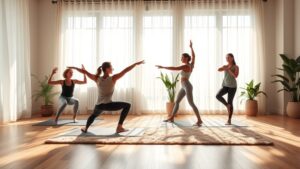Should you have ever dealt with bone marrow edema, you know it can be pretty uncomfortable. The positive news is that you don’t have to let it dictate your life. You can try some simple, effective exercises right at home that may help ease the discomfort. From gentle leg stretches to ankle mobility work, these movements can enhance circulation and strengthen your legs. Curious about how these exercises can make a difference? Let’s take a closer look!
Gentle Leg Stretches
At the time you’re managing bone marrow edema, the last thing you want is for stiffness to hold you back. Including gentle leg stretches can be a game changer.
Next time you feel tension, try calf and hamstring stretches to improve blood flow and reduce discomfort. Stretching your quadriceps and hip flexors also boosts your mobility. Hold each stretch for 15-30 seconds, breathing deeply as you go—it’ll help your muscles relax.
Make these stretches a part of your daily routine; they not only promote flexibility but also support your recovery process through aiding lymphatic drainage.
With each gentle stretch, you’re creating the opportunity for more ease in movement, moving closer to relief and a fuller life.
Isometric Muscle Engagement
Gentle leg stretches can lay a solid foundation for your recovery, but adding isometric muscle engagement to your routine can take your progress to the next level.
Isometric exercises, like isometric plank holds and static squat variations, let you strengthen muscles without moving your joints. This approach is essential in addressing bone marrow edema, as it maintains muscle mass while reducing strain.
You can also incorporate wall push-up adjustments to improve stability and promote blood circulation, aiding the healing process. These static exercises can alleviate pain, improve functionality, and elevate your confidence.
Plus, they’re often safer and easier to integrate into your routine, allowing you to stay active without aggravating your condition.
Low-Impact Leg Raises
Low-impact leg raises can be a breakthrough in your expedition towards alleviating bone marrow edema. This exercise improves circulation and helps reduce swelling effortlessly.
Here’s a quick benefits overview to get you motivated:
- Strengthens muscles around the affected area
- Improves overall leg mobility
- Supports fluid movement to clear swelling
- Easy to modify for any fitness level
- Requires no special equipment
To perform leg raises, lie on your back, legs extended. Lift one leg to a 45-degree angle while keeping the other flat to engage your core.
Aim for 10-15 repetitions on each leg with controlled movements for proper technique. Consider doing these daily to maximize benefits.
Just keep in mind, consistency’s key!
Ankle Mobility Exercises
Ankle mobility exercises can be a breakthrough regarding easing bone marrow edema. Start with ankle pumps: flex and extend your foot for 10-15 repetitions, several times daily. This simple move elevates circulation improvement and encourages fluid drainage in your lower legs.
Don’t stop there; try ankle circles too! Rotating your foot in circles improves joint flexibility and contributes to ankle strengthening. Participating in these mobility routines daily promotes comprehensive joint health, easing discomfort that comes with bone marrow edema.
And, should you want an extra lift, wiggle your toes! This also helps stimulate surrounding muscles, making your ankles more resilient. Accept these simple exercises, and watch your comfort soar. You’ve got this!
Seated Toe Movements
Seated toe movements can be a simple yet effective way to improve circulation in your feet and lower legs. They’re easy to perform, even from a chair or the edge of your bed.
Integrating these movements into your daily routine could help reduce swelling from bone marrow edema while enhancing blood flow. Here’s how to get started:
- Flex and extend your toes.
- Perform 10-15 repetitions, focusing on contraction and relaxation.
- Combine with ankle pumps for added benefit.
- Consider a foot massage afterward to promote relaxation.
- Follow proper footwear recommendations to support your feet.


